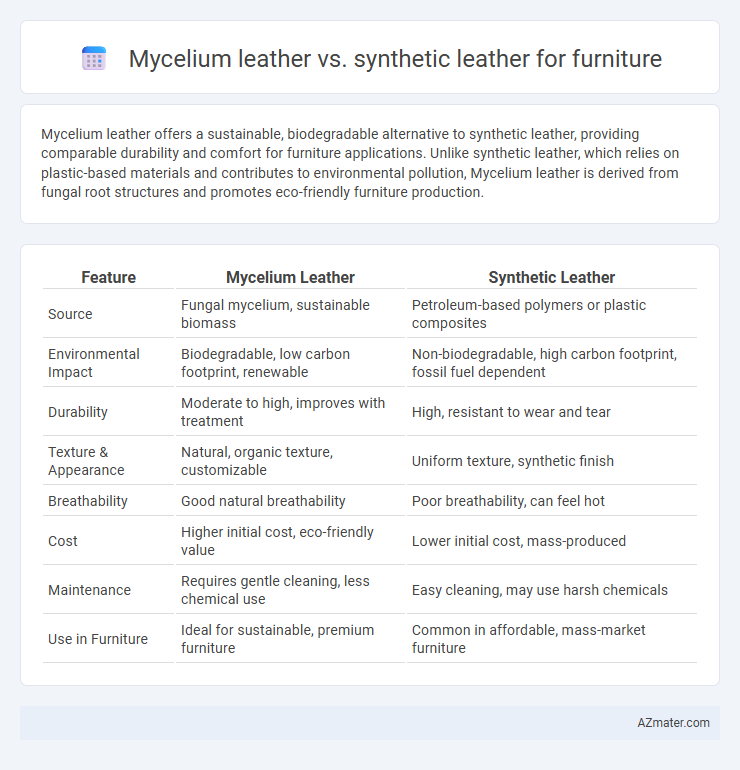Mycelium leather offers a sustainable, biodegradable alternative to synthetic leather, providing comparable durability and comfort for furniture applications. Unlike synthetic leather, which relies on plastic-based materials and contributes to environmental pollution, Mycelium leather is derived from fungal root structures and promotes eco-friendly furniture production.
Table of Comparison
| Feature | Mycelium Leather | Synthetic Leather |
|---|---|---|
| Source | Fungal mycelium, sustainable biomass | Petroleum-based polymers or plastic composites |
| Environmental Impact | Biodegradable, low carbon footprint, renewable | Non-biodegradable, high carbon footprint, fossil fuel dependent |
| Durability | Moderate to high, improves with treatment | High, resistant to wear and tear |
| Texture & Appearance | Natural, organic texture, customizable | Uniform texture, synthetic finish |
| Breathability | Good natural breathability | Poor breathability, can feel hot |
| Cost | Higher initial cost, eco-friendly value | Lower initial cost, mass-produced |
| Maintenance | Requires gentle cleaning, less chemical use | Easy cleaning, may use harsh chemicals |
| Use in Furniture | Ideal for sustainable, premium furniture | Common in affordable, mass-market furniture |
Introduction to Mycelium Leather and Synthetic Leather
Mycelium leather, derived from the root structure of mushrooms, offers a sustainable and biodegradable alternative to synthetic leather, which is made from plastic-based materials like polyurethane or polyvinyl chloride (PVC). This innovative bio-fabricated material mimics the texture and durability of traditional leather while reducing environmental impact through lower carbon emissions and non-toxic processing. Synthetic leather, although widely used for furniture due to its affordability and resistance to water and stains, contributes to plastic pollution and lacks the breathability and ecological benefits provided by mycelium leather.
How Mycelium Leather is Made
Mycelium leather is crafted by cultivating the root structure of fungi, allowing the mycelium to grow in controlled environments where it forms dense, fibrous mats. These mats are then harvested, pressed, and tanned using eco-friendly methods to achieve durability and texture similar to traditional leather. In contrast to synthetic leather produced from plastic-based materials like polyurethane or PVC, mycelium leather offers a biodegradable and sustainable alternative with a significantly lower carbon footprint.
Production Process of Synthetic Leather
Synthetic leather for furniture is produced through a multi-step process involving the coating of a textile base, typically polyester or cotton, with polyurethane (PU) or polyvinyl chloride (PVC) to mimic the texture and appearance of genuine leather. The production includes extrusion, embossing, and curing stages to achieve durability, flexibility, and water resistance required for upholstery applications. Innovations in synthetic leather manufacture emphasize eco-friendly solvents and reduced VOC emissions to lessen environmental impact while maintaining cost-effectiveness and consistent quality.
Environmental Impact Comparison
Mycelium leather, derived from fungal mycelium, offers a biodegradable and rapidly renewable alternative to synthetic leather, which is primarily petroleum-based and non-biodegradable. The production of mycelium leather generates significantly lower carbon emissions and consumes less water compared to synthetic leather manufacturing, reducing overall environmental impact. Mycelium leather also decomposes naturally without releasing toxic chemicals, whereas synthetic leather can persist in landfills, contributing to long-term pollution and microplastic contamination.
Durability and Longevity Analysis
Mycelium leather offers superior biodegradability and resistance to wear compared to synthetic leather, making it a sustainable choice with promising durability for furniture applications. Synthetic leather, often made from polyurethane or PVC, provides consistent water resistance and ease of maintenance but tends to crack and peel over time under heavy use. Evaluating longevity, mycelium leather's natural fiber structure allows for enhanced breathability and gradual aging, whereas synthetic leather typically exhibits shorter lifespan due to material degradation from UV exposure and frequent abrasion.
Comfort and Aesthetic Qualities
Mycelium leather offers superior breathability and a soft, natural texture that enhances comfort in furniture applications compared to synthetic leather, which tends to be less permeable and can feel sticky or plasticky. The aesthetic qualities of mycelium leather showcase unique organic patterns and a rich, natural appearance that ages gracefully, while synthetic leather often presents a uniform, artificial look that can crack or fade over time. Both materials provide customizable options, but mycelium leather stands out for its eco-friendly appeal and ability to deliver a warm, inviting ambiance in interior design.
Cost and Market Availability
Mycelium leather offers a cost-effective and eco-friendly alternative to synthetic leather, with production expenses often lower due to its rapid growth and minimal resource requirements. Synthetic leather dominates market availability, benefiting from established mass production and lower initial material costs, but it involves petrochemical inputs and limited biodegradability. Furniture manufacturers increasingly evaluate mycelium leather for sustainable collections despite its niche market presence and comparatively evolving supply chains.
Maintenance and Care Requirements
Mycelium leather requires minimal maintenance, needing only occasional wiping with a damp cloth and natural conditioners to maintain its durability and appearance, making it suitable for eco-conscious homeowners. Synthetic leather demands regular cleaning with mild soap and water to prevent cracking and peeling, and it often requires treatment with specialized conditioners to extend its lifespan. Both materials react differently to sunlight and moisture, with mycelium leather generally showing better breathability and resistance to wear over time.
Suitability for Furniture Applications
Mycelium leather offers superior breathability, flexibility, and eco-friendliness, making it highly suitable for sustainable furniture upholstery and cushioning. Synthetic leather, while typically more durable and water-resistant, often lacks the natural texture and biodegradability that enhance comfort and environmental impact in furniture applications. Choosing between these materials depends on prioritizing sustainability and aesthetic appeal versus durability and cost-efficiency in furniture design.
Future Trends in Sustainable Furniture Materials
Mycelium leather is gaining traction as a biodegradable and renewable alternative to synthetic leather in sustainable furniture, offering low environmental impact through its rapid growth from fungal root networks. Synthetic leather, typically made from petroleum-based plastics, faces growing scrutiny due to its reliance on non-renewable resources and limited recyclability, prompting innovation towards bio-based variants. Future trends highlight the integration of mycelium leather with circular economy principles, emphasizing carbon sequestration, waste reduction, and enhanced durability in eco-conscious furniture design.

Infographic: Mycelium leather vs Synthetic leather for Furniture
 azmater.com
azmater.com